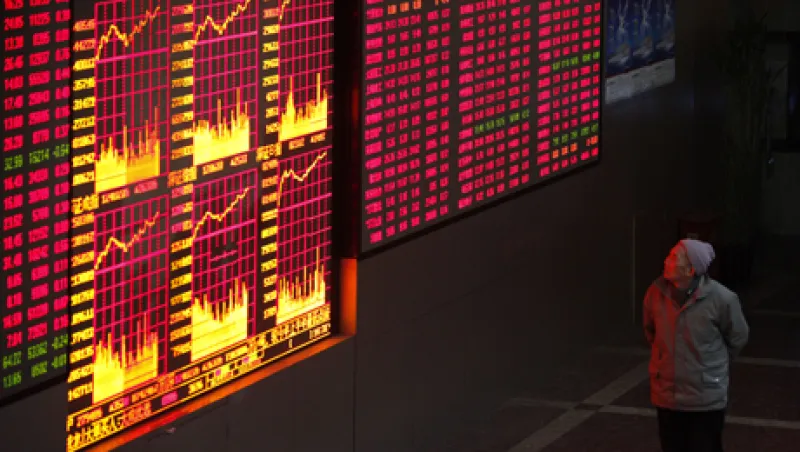Mainland China’s stock market reached a three-year trough this week, hit by the deadly combination of fresh fears about the Chinese economy and the absence of signs that the government is going to take aggressive steps to allay them.
The Shanghai Composite fell to as low as 2,033 on Thursday — 20 percent down on the year and 67 percent below its 2007 peak of 6,124. The disparity between the precredit crunch apex and the sober reality of today’s price is wide, even when compared with other hard-hit indexes such as the Eurofirst 300 index of euro zone stocks, down 34 percent from peak to now, or even the S&P Nifty index in India, a country whose economic performance, stymied by a lack of deregulation, has disappointed investors. That is down 16 percent.
A conventional economic reason for Chinese equities’ poor performance is the uncertain prospects for the economy. In the second quarter official gross domestic product growth dropped to a three-year low of 7.6 percent year-over-year. To serve the many analysts who distrust official Chinese GDP figures, a cottage industry has sprung up, estimating economic activity by looking at a range of numbers. One of them, Capital Economics’ China Activity Proxy, points to a further downturn in July — indicated by slow growth in demand for electricity output and weak construction activity. Meanwhile, official figures for industrial profits, published on Monday, reveal a worrying 5.4 percent year-over-year drop for July.
However, the government is constrained from delivering a powerful monetary and fiscal boost to economic growth because of its memory that the last such boost, in response to the credit crunch of 2008, pushed up inflation rapidly.
Looking to the longer term, investors are also fearful that the current model for rapid Chinese economic expansion is not sustainable.
The country’s meteoric progress so far — with consistent double-digit percentage increases in GDP, or close to them, for the past 20 years —has been based on the twin foundations of high exports and strong public investment.
However, the slowdown in the global economy pushed export growth down to only 1 percent year-over-year in July — the lowest in six months — and HSBC Bank’s August manufacturing purchasing managers’ index for China indicates that new export business declined at its fastest pace in more than three years.
Moreover, there are signs that recent levels of investment are not, in the long term, sustainable. Investment as a share of GDP reached a record high of 49 percent in 2011. Some analysts say this makes sense in a rapidly developing economy, which needs state-of-the-art infrastructure to allow goods, services and people to move easily around, and out of, the country. China’s capital stock per worker is less than a tenth of the U.S. level, suggesting plenty of room for growth in theory. However, the central government has grown wary of excessive encouragement of state-funded capital projects because of signs that much of the money is wasted — with the ghost city of Chenggong in southwest China simply one of the more spectacular examples. A more rational allocation of public investment requires a reduction in the corruption among officials which often leads to projects that, in pure economic terms, look irrational. It is not clear that China can achieve this.
Even for those analysts optimistic that China can keep its economy growing rapidly, there is a conceptual problem: Will economic expansion return Chinese equity prices to their previous heights?
The stock boom of 2007 was a bubble, judging by the conventional measure of the relationship between prices and the underlying income that supported them. The price-earnings ratio for Shanghai Stock Exchange ‘A’ Shares — those equities denominated in renminbi — rose to a peak of just above 70. However, in the years since Lehman collapsed in September 2008, the ratio has never risen above 30. On Thursday it stood at 11. For the index to return to its 2007 peak would require the Chinese retail investors who had bid the market up to return to the same feverish irrationality — measured mathematically by the price-earnings ratio — that they showed before.
Is it reasonable, however, to believe that economic growth will produce a future boom in the Shanghai market, albeit less spectacular than the last one? The argument is defensible — higher economic growth should increase corporate earnings, which underlie share values — but not impregnable. Skeptics point to Chinese equities’ mediocre performance over the past decade, despite the country’s stellar economic growth. Since August 2002, the Shanghai Composite has risen by only 22 percent. Analysts credit this anomaly to high equity issuance by Chinese companies, which has depressed earnings per share even as the growth in the economy has acted to push this measure up.
If most equity investors have not made money from Chinese economic growth — apart from those clever (or simply lucky) enough to get out at the peak of the 2007 boom — then who has? The clearest winners are investors in commodities and commodity-based currencies, which have profited from a global commodity boom based largely on Chinese demand. The price of front-month copper futures on the Chicago Mercantile Exchange is 424 percent higher than a decade ago. The Australian dollar, regarded as perhaps the ultimate currency play in the foreign exchange market, is 88 percent up over the same period. The best China investment plays remain, in the view of many, those outside the Middle Kingdom itself.






